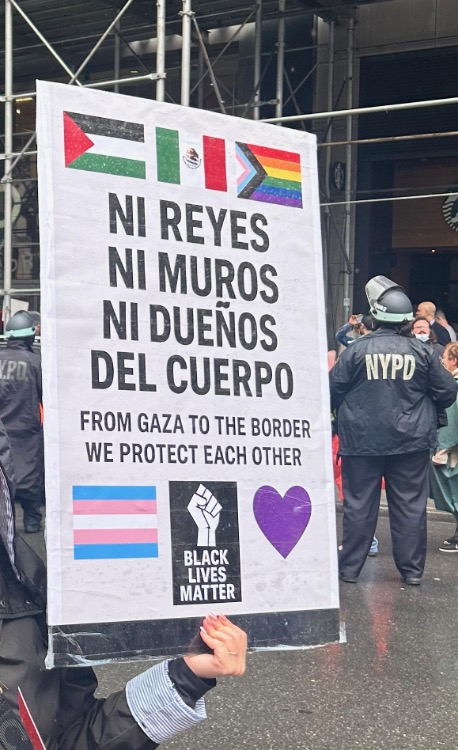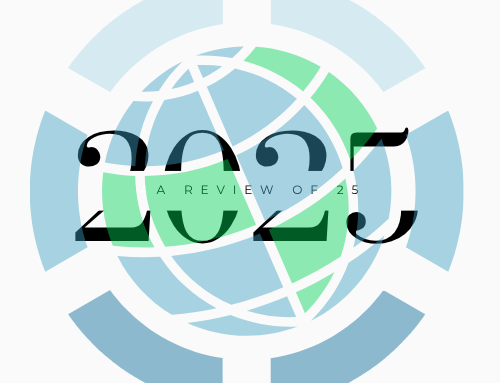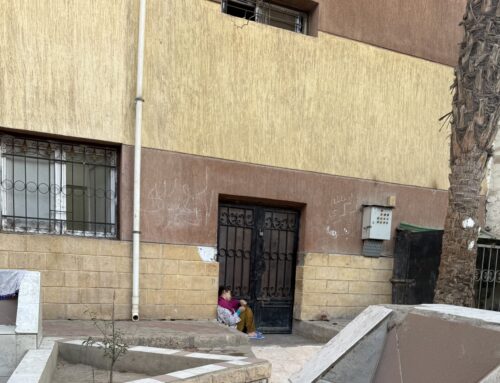
“No Kings Day” sign in New York City, June 14, 2025. Photo by Alexandra Délano Alonso.
I began writing this essay in June 2025 as the Trump administration deployed 4,000 National Guard troops and 700 Marines in Los Angeles, in response to protests against immigration raids. Meanwhile, the city’s police (LAPD) used tear gas, rubber bullets and pepper spray against what had been a mostly peaceful mobilization with music, dance, and free food.
The protests in downtown LA were echoed in other cities around the country and joined a national call to action for “No Kings Day” on June 14, 2025. These actions were reminiscent of other pivotal moments in the history of mobilizations around immigration policies, including the marches against Proposition 187 in 1994 and the Sensenbrenner Bill (HR4437) in 2006, the Dreamers movement in 2010, and protests on the streets and at airports against the first Trump administration’s Muslim Ban and its broader immigration agenda. In this case, the call to the streets in LA was a response to the harsh escalation of immigration enforcement actions by the Department of Homeland Security’s office of Immigration and Customs Enforcement (ICE) since the start of the Trump administration in January 2025.
The detention, deportation, and border control practices we are seeing now are unprecedented at many levels, but they are also the result of an infrastructure, a narrative, and a system built over decades that criminalizes migrants. At the same time, the Trump administration’s extension of this apparatus and its expansive targeting of diverse groups has produced conditions for new and strengthened forms of coalition-building across different struggles.
Protesting expanded ICE powers
The Los Angeles protests were a direct challenge to a string of mass raids in workplaces and parking lots where day laborers gathered. Since January, thousands of immigrants have been detained across the country, and raids have also impacted advocates, family members, and neighbors who try to protect those being violently taken away. In LA, this included the detention of David Huerta, a union leader who was arrested and injured while documenting an ICE raid. Huerta, like many others, had come out to the streets to denounce the raids in restaurants and other workplaces, and the fact that thousands of people are being detained and disappeared in the detention system without accountability, and possibly deported to a country where they are not citizens. Some people face detention or imprisonment in countries where they have no access to legal aid or support systems.
In New York, where I live, daily mobilizations have been taking place over the past months to protest ICE’s new strategy to arrest immigrants with legal status who go to court for scheduled hearings and routine check-ins, as was the case of Dylan Lopez Contreras, a high school student from Venezuela.
The longstanding call to abolish ICE is loudly heard on the streets at these protests and rallies, as communities reel from the expansion of its actions around the country to meet arbitrary quotas for daily arrests (reportedly established at 3,000 in May and later denied by the Trump administration). In July, new legislation allocated $75 billion to ICE’s budget, a 265% annual increase. This funding supports the continued expansion of ICE’s most recent strategies, including abductions of immigrants of different statuses on the street and in their cars by undercover plainclothes officers; raids in workplaces and day laborer gathering areas; detentions by masked agents at schools and courts (which had previously been protected as “sensitive locations”); egregious violations of rights to due process and legal representation; deportations to third countries; defiance of court orders; and erroneous detentions of citizens. The Trump administration has also invoked wartime powers to deport immigrants and deploy the National Guard, now not only to control immigration at the border but also to support ICE’s interior enforcement actions.
ICE and border patrol agents’ abuse of power, the inhumane conditions inside detention centers, and the negative impact of deportations on the health and wellbeing of those detained and those they are separated from are well known and have been widely documented over the years. Trump and his allies have expanded this enforcement infrastructure without facing much opposition at the level of political process, including the defiance of a judicial system whose limits are being exposed. Their agenda has been met with a deafening silence and the absence of an alternative vision from the Democratic party.
As communities around the country start to mobilize more actively on the streets to challenge these actions and call for an end to immigration enforcement, Trump has threatened to use “equal or greater force” than already shown in Los Angeles through the deployment of the military in the face of an “emergency.” This “crisis” framing has been used before, in the US and in other places, to justify militarization, police violence, disappearances, and the suspension of democratic liberties. We are now seeing how far that logic can be taken.
An expanded and intersectional struggle
As I marched alongside the “No Kings” protesters in New York City in June, a wide range of colorful and inventive signs denounced tyranny, oligarchy, fascism, and racism. Protestors called for a defense of democracy, the constitution, and funding for health and education instead of war, prisons, or ICE. Many people carried a specific red and white printed sign that on one side demanded the end of repression against the pro-Palestine movement and the release of Mahmoud Khalil, the Columbia student who was detained by ICE due to his participation in campus protests in support of Palestinian liberation. The other side called to “stop the raids and deportations” and “full rights for immigrants.”
I have observed and participated in different public actions focused on immigration in the US and Mexico over the last two decades. What is most salient to me in recent years is the way mobilizations on immigration have encompassed a much broader movement that connects different struggles and makes structural demands that cut across issues, with a transnational perspective. An example is the sign in the photograph that accompanies this article: “No Kings, No Walls, No Ownership over our Bodies: From Gaza to the Border We Protect Each Other,” alongside the Palestinian, Mexican, LGBTQ+ and Transgender flags, the Black Lives Matter symbol, and a purple heart.
The protests in Los Angeles and other places are expressions of a social movement that has been building over years and regrouping over the last months. This effort is not just to revamp the work and the coalitions built to fight against Obama’s deportations, the first Trump administration, or Biden’s externalization of border enforcement strategies to Mexico and other countries. This moment is bringing forth formations and narratives that have been emerging over many years, and that go beyond the immigration debate. These narratives and actions address larger questions about the protection of democratic freedoms for citizens and non-citizens alike, and the need to transform underlying structures of inequality and racism.
The first Trump administration’s attacks against many groups had already broadened the struggle beyond the issue of undocumented migration, given his attacks against Muslim communities, Temporary Protected Status (TPS) holders from many different countries, women, LGBTQ+, Muslim, Black and Indigenous peoples. Communities that had previously organized for immigration reform, for regularization of status, or for protections against deportations, shifted towards a framework of expanded sanctuary, defunding, and abolition. These movements centered the realities of racism, precarity, and criminalization against marginalized communities that underpin not just immigration policies, but intersect with systems of mass incarceration and policing, labor exploitation, gender-based violence and racial profiling, regardless of citizenship.
Neither calls for comprehensive reform (which haven’t gotten past Congress in over 25 years), nor promises of “humane approaches to enforcement” (an oxymoron that the Biden administration used to defend its policies), address the foundations that Trump is now building upon to feed a narrative of fighting an “immigrant invasion” in the name of “civilization.” This narrow and hypocritical vision has long shaped the immigration system in the US and is now expressed in one of its most extreme versions.
This time, the idea of the “foreign threat” explicitly includes legal permanent residents, international students, visa holders, pro-Palestine student protesters, and trans-people, and has justified new travel bans against 12 countries. The attacks by the Trump administration have never been only against the rights of immigrants, but now they are explicitly bound up with values and practices at the core of American democracy: threats against freedom of speech, freedom of the press, freedom to assembly and petition. The conditions for organizing have become extremely challenging in a new climate of fear and repression. Organizers also face the defunding of numerous programs that supported migrant-serving organizations in the US and other countries, as well as threats against educational institutions, law firms, foundations, and non-profit organizations.
Building alternatives
It is a hard moment for hope in the US and in many places where anti-immigrant policies, militarization, and nationalist logics have continued to gain voters’ support, without regard for their own implication in the loss of human life and the exacerbation of conditions of violence and inequality that affect everyone. The pulse of groups who have long been resisting, refusing narratives of criminalization and binaries of citizen/non-citizen, and practicing alternatives grounded in dignity and mutuality, is very much alive. We saw public expressions of it on the streets in June, but it is present every day in local actions to build community spaces enacting structural changes toward abolition, freedom, mutual protection.
New networks of sanctuary and accompaniment formed during the Obama administration, strengthened during the first Trump administration, and then evolved into mutual aid and community support groups that organize around migration justice and beyond. They organize for community gardens, land defense, and environmental justice; they organize for dignified and affordable housing; they organize for transformative justice against policing, militarization and criminalization; they organize for peace and self-determination; they organize for the right to remain; for freedom and safety regardless of citizenship. They have not stopped. They continue to adapt and evolve in response to current conditions. The struggle is not for a return to what was there before Trump. If an alternative is to come, these larger intersectional narratives and practices offer both lessons in collective resistance and in the possibility of building something new.
Alexandra Délano Alonso is Professor of Politics and Global Studies at The New School and Eugene M. Lang Professor for Excellence in Teaching and Mentoring. Her work examines movement building across borders through networks of migrant organizations, mutual aid, and memorial projects. Her recent publications include the co-edited volumes New Narratives on the Peopling of America: Immigration, Race and Dispossession (Johns Hopkins University Press, 2024) and The Struggles for Memory against Violences in Mexico (El Colegio de México, 2023).
Cite as: Délano Alonso, Alexandra. 2025. “Organizing Against Immigration Enforcement and Beyond”. In “Bordering and the War on Migration”, edited by Simone Reumert, Wendy Vogt, and Charlie Piot, American Ethnologist website, 23 September 2025. [https://americanethnologist.org/online-content/organizing-against-immigration-enforcement-and-beyond-by-alexandra-delano-alonso/]
This piece was edited by American Ethnological Society Digital Content Editor Kathryn E. Goldfarb (kathryn.goldfarb@colorado.edu).




